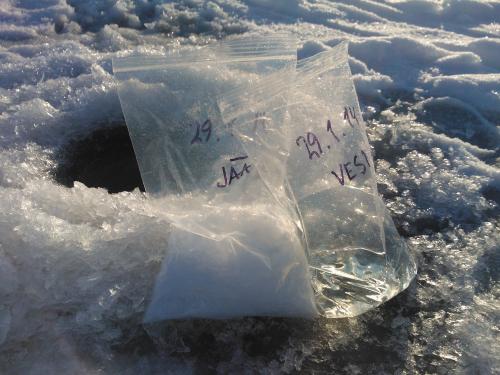Freezing technology can be utilised in waste water treatment. When waste water freezes, it is purified through the formation of a cleaner layer of ice. The clean layer of ice can be removed from the rest of the waste water, and the remaining waste water is more concentrated.
The new energy-efficient method of purification is based on the natural freezing process of water: energy is required only for breaking the ice and transporting it from the waste water pool.
 In practice, this method could be used by leaving waste water from mines to freeze in special pools under the open sky, after which the cleaner part could be removed by breaking the ice. After that the ice would be taken away using a machine designed for that purpose to another pool where the treated waste water would be recycled, or undergo further treatment using membrane filtration, for example, for the needs of various processes. Recycling water from the industrial process would reduce the amount of fresh water that is used.
In practice, this method could be used by leaving waste water from mines to freeze in special pools under the open sky, after which the cleaner part could be removed by breaking the ice. After that the ice would be taken away using a machine designed for that purpose to another pool where the treated waste water would be recycled, or undergo further treatment using membrane filtration, for example, for the needs of various processes. Recycling water from the industrial process would reduce the amount of fresh water that is used.
The method is being developed at the Lappeenranta University of Technology, LUT for application mainly in the extractive industry, which produces large amounts of waste water. The freezing of water – or to use chemical terminology, its crystallisation – requires seven times less energy than its evaporation.
Equipment developed by LUT chemical technology researchers includes a winter simulator which makes it possible to study how the temperature of cooling air affects freezing. The simulator has been used to study the growth rate of the layer of ice that emerges, and the degree of purity when salt solutions of different concentrations are used. Last winter researchers also took samples on the ice of Lake Saimaa.
“We took samples of both the lake water and the ice and we examined the amount of impurities that they contained. The result was that the lake water contained about ten times more impurities than the ice. Another finding in the research was that the slower the layer of ice grows, the cleaner the ice is. Therefore, the purity of the ice is directly dependent on its rate of growth”, says Chemtech Professor Marjatta Louhi-Kultanen, who is specialised in the study of crystallisation. According to Professor Louhi-Kultanen, future research will be aimed at an extensive examination of different types of waste water pools and the purity of their layers of ice and the implementation of freezing experiments with waste water samples in mining areas.
Source: http://phys.org/
Dear User/Visitor! Please, answer on our questions: tick off one of the positions – your answer will make us able to improve our site and make it more interesting and useful!

